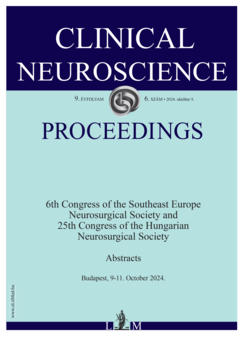New perspectives in neurosurgery: Augmented reality
ORBAY Péter1, SIPOS László1
2024. OKTÓBER 09.
Ideggyógyászati Szemle Proceedings - 2024;9(6)
ORBAY Péter1, SIPOS László1
2024. OKTÓBER 09.
Ideggyógyászati Szemle Proceedings - 2024;9(6)
Szöveg nagyítása:

Introduction: Augmented reality (AR) is a set of different technologies, all aiming to project virtual content into the real environment, compared to virtual reality, where the user is immersed in a computer generated world. Neurosurgery has always been at the forefront of this technology, and gives the greatest contribution to the literature. During the past two decades neuronavigation has been an essential tool trying to achieve maximal safety and minimal invasiveness.
Aims: In our examination we aim to overview the present state of art usage of AR in neurosurgery and demonstrate our initial experience of AR assisted transsphenoidal pituitary tumor resections.
Methods: We surveyed the Pubmed database for systematic reviews of AR assisted neurosurgery and tried to adapt the results in our transsphenoidal operations using the Medtronic Stealth Station8 neuronavigation system.
Results: Conventional navigation and imaging technologies have tremendously advanced neurosurgery, however the ergonomics of the devices are not optimal. The neurosurgeon has to look away from the surgical field to a dedicated workstation screen, then transfer the 2D information back to the operative situation. The injection of multimodal images (MRI, CT, angiography or tractography) can reduce operation time, the frequency of revisions and the radiation exposure (particularly in spine surgery screw insertion). AR has brought major advances in education and precision of tumor resections. In our few cases AR helped in the identification the main landmarks of the sellar region, the internal carotid arteries, the optic nerves and the pituitary gland itself.
Conclusion: The use of AR is significantly increased in the past decades. Nowadays it is mainly used in spine surgery and education. AR assisted neuronavigation using the real data source of microscope or endoscope can improve outcomes in transsphenoidal surgery in landmark identification especially in patients with anatomical variations.
Ideggyógyászati Szemle Proceedings
Despite evidence based institutional protocols being in place in many countries, aneurysmal subarachnoid hemorrhage (SAH) continues to be a major socio-economic burden with many open questions remaining regarding the optimal management of the affected patients.
Ideggyógyászati Szemle Proceedings
Arteriovenous malformation (AVM) is an anomaly of blood vessel formation. Numerous models have been established to understand the nature of AVM.
Ideggyógyászati Szemle Proceedings
Additive manufacturing has gained significant traction in industrial applications due to its high potential when it comes to manufacturing objects with complex geometry.
Ideggyógyászati Szemle Proceedings
Not only other surgical and robotic fields, but minimally invasive procedures in spine surgery have undergone significant development in recent times. A demand emerged from both surgeons and patients to develop and perform these types of surgeries in order to prevent biomechanical and surgical complications.
Ideggyógyászati Szemle Proceedings
Functional magnetic resonance imaging (fMRI) is crucial for presurgical language mapping in neurosurgery, helping identify eloquent brain regions to preserve during operations. Effective language mapping depends on advanced fMRI acquisition and detailed data analysis to ensure accurate clinical outcomes.
Lege Artis Medicinae
A Nobel Alapítvány bejelentette, hogy sok magyar várakozásának, reményeinek megfelelően Karikó Katalinnak és Drew Weissmannek ítéli az idei orvosi és fiziológiai Nobel-díjat, a Covid-oltásokat megalapozó módosított mRNS-technológia kifejlesztéséért. Duda Ernő virológussal, a Szegedi Tudományegyetem Szent-Györgyi Albert Orvostudományi Kar emeritus professzorával beszélgettünk a díj hátteréről.
Ideggyógyászati Szemle Proceedings
A Magyar Neuroimmunológiai Társaság X. Kongresszusa Absztraktfüzet Siófok, Magyarország 2023. október 26–28.
Lege Artis Medicinae
A Kísérleti Orvostudományi Kutatóintézet Rendszer-Neurobiológia Kutatócsoportjában a fő célkitűzésünk a kognitív folyamatok agyi mechanizmusainak jobb megértése. A tanulás, memória, figyelem és döntéshozás idegrendszeri alapjait nemcsak normális körülmények között, hanem kóros állapotokban is vizsgáljuk, különös tekintettel a neurodegeneratív dementiákra, mint az Alzheimer- és a Parkinson-kór.
Lege Artis Medicinae
Az 1922-ben felfedezett inzulin cukorbetegek millióinak életét mentette meg és javította életminőségüket, a téves/helytelen/bűnös használata azonban károkat, sőt halált is okozhat.
Ideggyógyászati Szemle Proceedings
A Magyar Neuroimmunológiai Társaság X. Kongresszusa Absztraktfüzet Siófok, Magyarország 2023. október 26–28.
Augmented reality and “non-rigid navigation” in neurosurgery
Az idős beteg és a bőronkológia: fókuszban a szűrés jelentősége
1.
2.
3.
4.
5.
Egészségpolitika
Hadiállapotként kezeli és így is reagál a kormány az egészségügy „rendezésére”1.
2.
3.
4.
5.